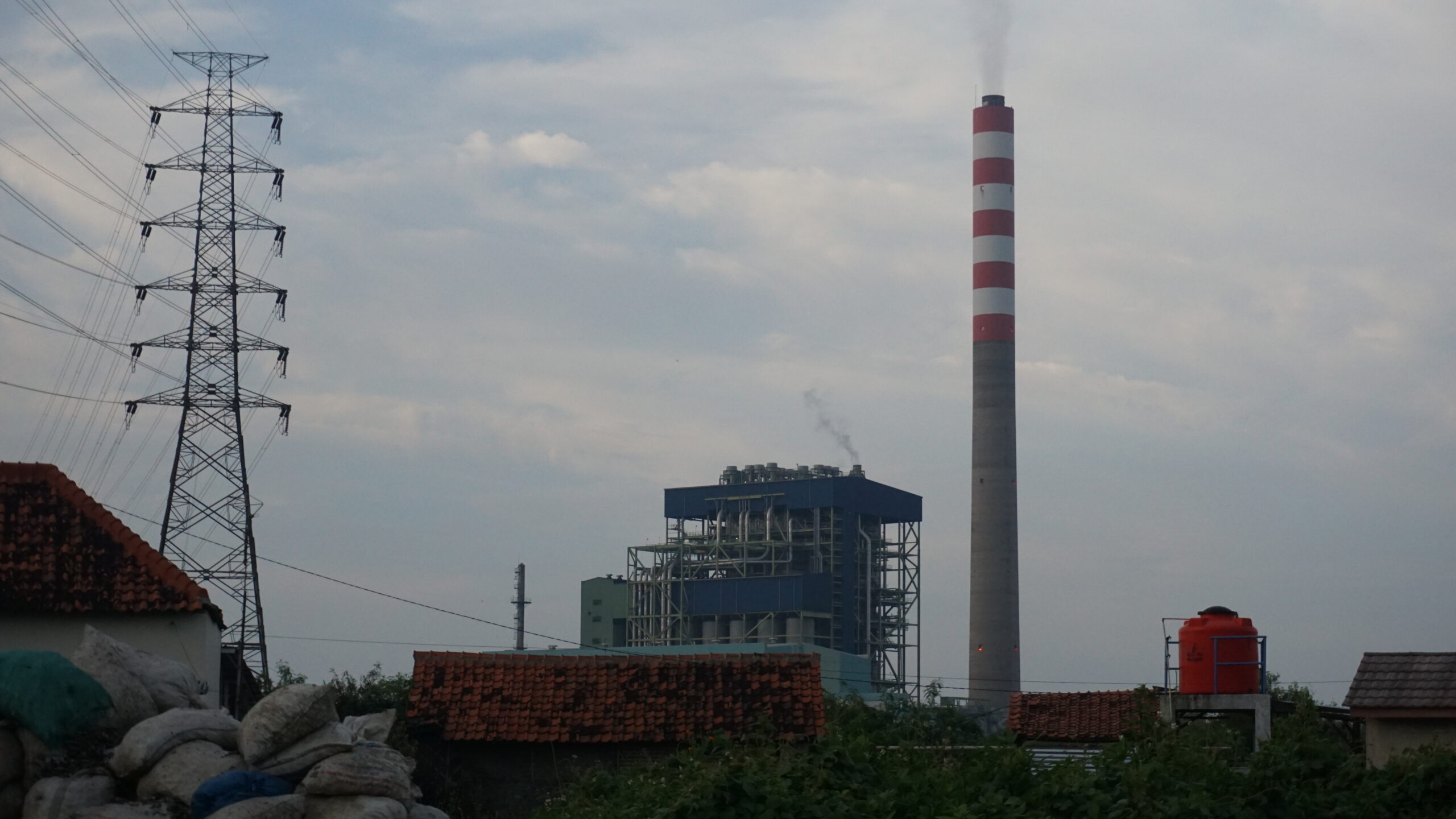
Climate Justice | June 22, 2024
Seeking Justice in Cirebon Energy Transition
Sri Handayani Nasution
When we arrived in Waruduwur Village, Cirebon, the heat became more oppressive as we walked closer to the coal power plant. The roar of the engine was audibly clear near the residential area. As we gazed to the sky, the chimney was visible, with coal-fired smoke billowing from the tip of it.
Waruduwur Village is located right beside the Cirebon Power Plant 1 or PLTU 1 Cirebon. According to the agreement between the Asian Development Bank (ADB), PT Cirebon Electric Power, and Indonesia Investment Authority (INA), the power plant will be subjected to the coal phase out plan and decommissioned by 2035, 7 years earlier than planned.

Gambar 1. Cirebon Power Plant 1 standing right beside the people’s houses
Indonesia has declared its commitment to conduct energy transition towards cleaner energy. Currently, Indonesia’s energy sector is the second largest contributor for the CO2 emission. According to the Centre for Research on Energy and Clean Air (CREA), Cirebon power plant emits 90-kilogram of Mercury annually.[1] Cirebon power plant 1 also disperses other toxic pollutants to the air, including nitrogen dioxide (NO2), sulfur dioxide (SO2), mercury, lead, arsenic, cadmium and fine particulate matter, or PM2.5.[2]
There should be justice in energy transition, and this justice needs to consider both the environmental justice and the social justice for the people living in it. Especially those who live nearby. The plan to decommission the power plant in Cirebon, with the support of ADB, should prove the justice in the term of Just Energy Transition (JET) is not an empty and sweet promise.
Indonesia is a signatory of Paris Agreement in 2016, with the commitment to decrease CO2 emission entails with it. In 2023, Indonesia formed the secretariat of the Just Energy Transition Partnership (JETP) to accelerate the ambitious zero emission target in 2060. The plan is elaborate, well-intentioned, and ambitious.
However, it is unfortunate that all of this ambition and information is not disseminated throughly to the people who reside in the surrounding areas of Cirebon Power Plant 1, including the site that we visited—Waruduwur Village and Kanci Kulon VIllage. Meanwhile transparency and community engagement are imperative, and the first step listed in the Energy Transition Mechanism (ETM) from the ADB—a package of the investment plan and comprehensive policies from JETP. This is on top of the preexisting problem of the power plant, where justice seems like an alien word to describe the situation. When the energy transition plan comes in, we sincerely believe that it will not be achieved if the preexisting problems persist.
The Injustice Preceding the Energy Transition
We receive stories with the communities in Waruduwur Village, the term justice may not prevail in their stories when the coal power plant damages the surrounding environment, welfare, and wellbeing of the communities.
Most people in Waruduwur work as fisher people are struggling because the power plant emits excessive pollutants in their water. The environmental hazard affects the amount of sea products and what’s left for fisher people when the fish is not there to catch?
Without any mitigation and accountability from the corporation, the community will still bear the existing polluted burden on their own shoulders for another decade until the just energy transition plan is implemented.
Aside from the decreasing amount, they need to always be on alert as the sea products are intoxicated from the toxic substances from the power plant waste resulting in the high risk of poisonous fish and other sea products.[3]
Another impact of the environmental pollution is deteriorating health quality of the surrounding communities. The hazardous quality of water affects their domestic life, the water is unconsumable, surrounded by water, they ironically need to rely on freshly bought gallons of water from other areas increasing their financial burden. [4]
“For drinking, no. For cooking, also no. [We only use it] for washing our clothes and dishes. We use water gallon for cooking; therefore, our spending is excessive.” Mrs T, a fisherwoman, complained about the lousy water quality.
They are also exposed to the noise pollution from the constant engine roar of the power plant and the air quality is not any better. The communities inhale toxic pollutants and substances, the residue of the coal-fired power plant and its waste that cause lung and respiratory diseases.[4]
Scrutinizing the Gender Element in Cirebon Energy Transition
“After the power plant 1 and 2 were built, it [sea product] has been dramatically decreasing” Mrs N, a fisherwomen stated when asked about the impact of the power plant to their livelihood.
Gender sensitivity should be integral in the just energy transition, not an accessory or an afterthought. Currently, due to the power plant, the fisherwomen need to sail further to catch ukon (shellfish) as their usual fishing area near the power plant is polluted, now full of mud as tall as their waist. As their husbands fail to catch fish and other sea products due to the environmental pollution, the fisherwomen become the breadwinner of their family, however they also need to bear the burden of most of the domestic works in their home.
Other than the fisherwomen, most women in the surrounding areas need to bear similar double burden of their traditional role as wives and mothers. Many of them work as sheller workers to fund their family and their children’s welfare while also doing domestic work.
The women who become sheller workers need to work for more than 12 hours since 3am at dawn. It affects their health as they are constantly exposed to direct contact of sea products that hurt their skin. As they need to sit for hours long, they complain about the back pain they need to endure.
The women are not invited and involved in any formal or informal meetings in the village. It results to dismissal of the problems that many women bear, most of the stories they share to us are unheard and not advocated as a collective problem of the community. Even if at the end of the day the socialization from the stakeholders about energy transition is conducted, the chances for women to be involved is minimum.
There is limited amount of research that specifically focuses on the impacts of energy transition and the decommission of the power plant 1 to the women. The void of research and context analysis with gender perspective may result to women’s problems being overlooked and ignored. Without data, the policies will hardly accommodate women’s needs in energy transition.
Formulating Just and Gender Sensitive Energy Transition
With the presented evidence and data, we firmly believe that transparency and socialization only at the beginning of the project is insufficient. The empowerment and justice for the people surrounding Power Plant 1 Cirebon, before or after the energy transition, is imperative and central to the plan.
The performative reparation process should cease to exist and substantial reparation delivery for the communities should take place in the process of the decommission. Monitoring and evaluation process of any initiatives by the stakeholders needs to be conducted to ensure the reparation process is received by the most affected communities.
Gender perspective should become a central aspect of the energy transition by all stakeholders and the government, not an accessory, not an afterthought.
A real action that can be taken to ensure gender sensitive energy transition is to ensure the existence of gender-disaggregated data and research for policy-making and decision-making process.[5] It is integral to guarantee that the problems women currently face is visible, calculated, and accommodated during the energy transition in the future.
The impact of energy transition to women and men differs because of their embedded traditional roles. With full comprehension of these differences, the policy in the future can empower and be more accommodative to the women in the energy transition landscape.
At the end, there is no just in the future if the preexisting problems are unresolved and ignored. The just decommission process should not only be conducted in a decade, but starting from now, in the initial process.
[1] https://www.thejakartapost.com/longform/2023/08/31/silent-invisible-danger-at-cirebon-coast.html
[2] https://www.thejakartapost.com/longform/2023/08/31/silent-invisible-danger-at-cirebon-coast.html
[3] NGO Forum On ADB (2022), The Asian Development Bank’s Energy Transition Mechanism,
[4] Saputra et al (n.d). Potret Transisi Energi Indonesia Dampak Sosial Ekonomi di Akar Rumput Wilayah PLTU Cirebon.
[7] https://75inq.com/gender-and-the-energy-transition-the-hidden-face-of-women-in-energy-poverty/

